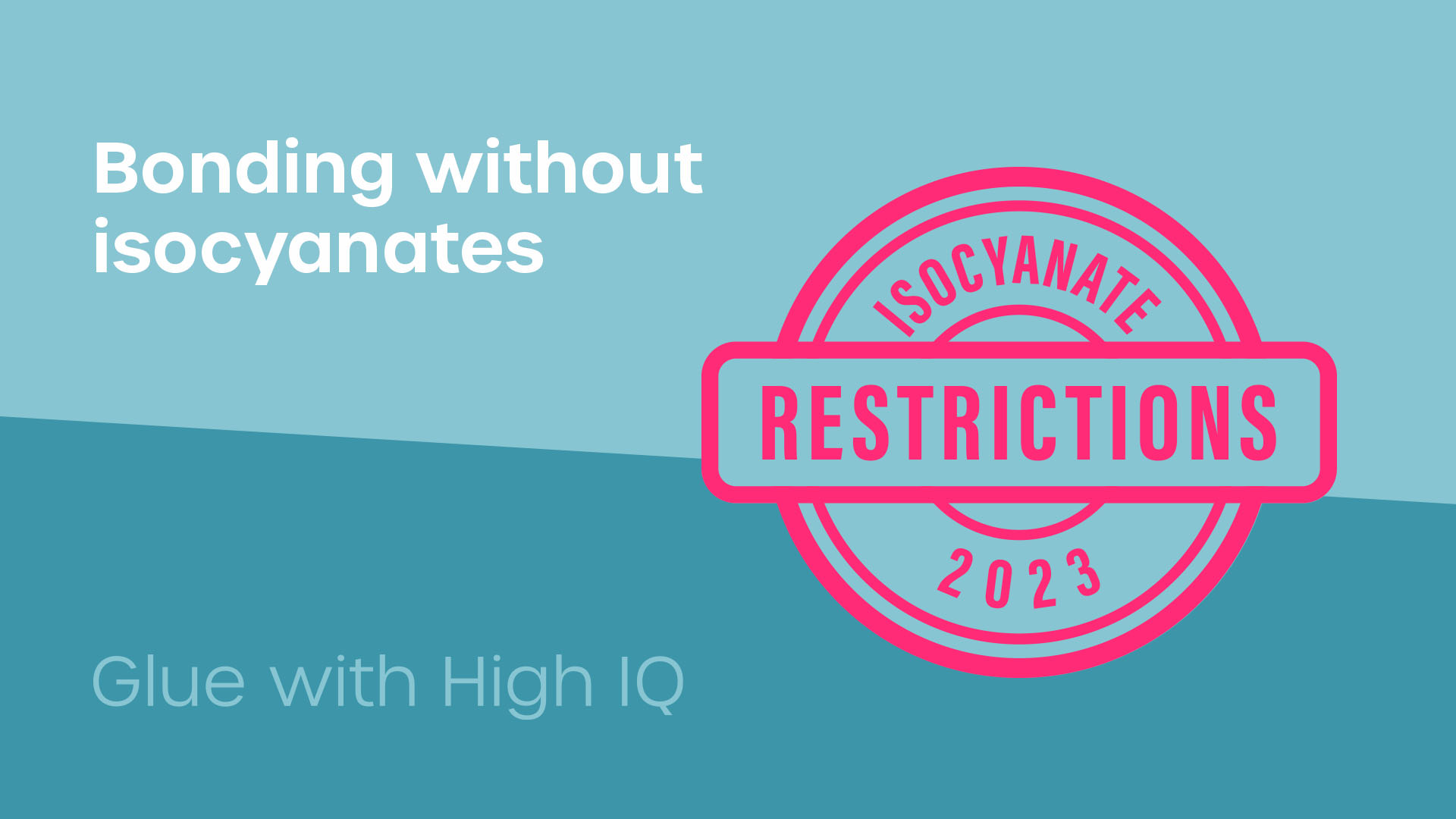Bonding without isocyanates; Alternatives to Polyurethane adhesive

As technologies advance and restrictions come into force, more and more companies are looking to move away from using polyurethane adhesives. You’re in that position but you’re not sure where to start looking for alternative adhesive solutions.
Companies often come to us and ask us for an alternative to a polyurethane product. As industrial adhesive manufacturers here at Forgeway, we know it’s not just as simple as finding a like-for-like product.
This article will explain why it isn’t so simple, then it will discuss alternative adhesive solutions to polyurethane. By the end of the article, you will have a good idea of which polyurethane adhesive alternative is best for your application.
Or, you can watch the video below which describes the best alternatives to polyurethane adhesives.
Why should you be considering alternatives to polyurethane adhesives?
Roll back five or ten years ago, polyurethane adhesives were one of the most popular adhesives. Whether you were looking for a structural adhesive, a sealant, or a contact adhesive, polyurethanes would certainly have been one of the first options to consider.
In 2023 it’s different.
There is a much greater selection of adhesive technologies available these days. Whilst this is a good thing (more options mean a greater chance of finding a good fit), it can also make it more difficult to make a decision.
So that’s the first reason you should be considering alternatives to polyurethane adhesives. Many in the adhesive industry would consider them outdated.
Some recent adhesive technologies have much greater performance capabilities such as faster cure and higher strength.
However, the main reason you should be considering non-polyurethane adhesive is due to the recent restrictions around isocyanates. You cannot use polyurethane adhesives for industrial purposes after August 2023 unless:
- The adhesive contains less than 0.1% diisocyanates
- The operatives have received training for the safe use of diisocyanates
As training isn’t a viable option for most companies, the option to explore non-polyurethane adhesives is usually the best solution for them.
So not only are polyurethane adhesives outdated, their use will be restricted as of August 2023.
What should you consider when changing adhesives?
So you’re going to change your adhesive, but what are some things you should consider at this stage?
Over the years, we have helped hundreds of companies change their adhesives. You will likely face resistance to change from internal stakeholders.
You must make sure everyone internally is aware that the change is great. The company should be aware that the problem you are facing is too great to let resistance to change get in the way.
Once you have overcome that hurdle, there are four steps we guide our customers through when changing adhesives.
- What are you bonding – this step is about understanding your substrates.
- How much time do you have – this will affect the open time and cure time of the adhesive.
- What characteristics do you need from your adhesive – factors like strength and flexibility, durability, and viscosity will affect your adhesive choice.
- How much are you willing to spend – of course, cost. You need to ensure you are getting a cost-effective solution.
If you have gone through each step and you’re confident you have put answers next to each step, you can then start to assess your polyurethane adhesive alternatives.
You now have the information and research to find the perfect solution for you. To find out more about each step, click the banner below to read about how to choose an adhesive.
What are the alternative options to polyurethane adhesives?
The alternative options to polyurethane adhesives will depend on your application and the type of polyurethane adhesive you are using.
There are several different types of polyurethane adhesives. However, the two main types are structural polyurethane adhesives and semi-structural/sealant polyurethane adhesives.
We will discuss alternative options for both types.
Alternatives to structural polyurethane adhesives
One alternative to structural polyurethane adhesives is epoxy adhesives. These adhesives are made from a mixture of resin and hardener.

Epoxy adhesives are highly versatile. There are several different types of epoxy adhesives and their characteristics can vary.
However, they typically would provide a strong bond that can withstand high temperatures and chemicals. They are also resistant to impact and vibration, making them suitable for industrial applications.
The other structural alternative is acrylic adhesives. Some call them methyl methacrylate adhesives. These are fast-drying adhesives that require minimal surface preparation.
Like epoxy adhesives, acrylic adhesives are also very versatile and can achieve a strong bond. They have good resistance to weathering and UV light.
Acrylic adhesives can achieve high-strength bonds to problematic surfaces like polypropylene (and other LSE plastics) without the need for primers or extensive surface preparation.
There are other structural adhesives available, but epoxy adhesives and acrylic adhesives are the main two alternatives to polyurethane adhesives. They will often far outperform polyurethane adhesives.
Alternatives to semi-structural/sealant polyurethane adhesives
Polyurethane sealants have been one of the most popular sealants for years. As polyurethane sealants also have good strength capabilities, some companies use them for semi-structural bonding too.
So you’ll need an alternative that can not only seal but can bond too.
One alternative to polyurethane sealants is silicone sealants. These sealants are made from silicone, a synthetic rubber.
Silicone sealants provide a flexible bond that can withstand extreme temperatures and weathering. They also have good resistance to chemicals and UV light.
This makes them a great alternative in applications such as construction, automotive, and electronic industries.
Silicones do not have the same strength capabilities as polyurethanes though. We would never recommend silicone sealants for replacing polyurethane sealants in semi-structural applications.
The other alternative is a hybrid sealant like MS polymer. As they are hybrid, they combine the benefits of silicones and polyurethanes.

Hybrid sealants have good strength and flexibility characteristics as well as good resistance to weathering, and UV light.
Unlike silicones and polyurethanes, MS polymer sealants do not have any health risks. They do not contain any chemicals that cause sensitization or harm to humans.
If you asked us the best alternative to polyurethane sealants, we would always recommend an MS polymer but you should also consider silicones.
There are several advantages and disadvantages to both options
Which polyurethane adhesive alternative should you choose?
You know why you should move away from polyurethane adhesives. You also know the alternative adhesive solutions. It’s time to make a decision about which route you would like to go down.
As industrial adhesive manufacturers here at Forgeway, we have helped hundreds of companies go through this change process. You may find it frustrating that you know you need to change.
The tips in this article will have given you a good idea of how to change. We understand that there are a wide variety of alternative adhesives available. It can be daunting to know where to start.
That’s why we narrowed it down to just two options.
If you are looking for an alternative to semi-structural/ sealant polyurethanes, we suggest you should explore silicones or MS polymers. They are the only two options that match (sometimes outperform) polyurethanes.
However, if you are looking for an alternative to structural polyurethane adhesives, we recommend looking at either epoxy adhesives or acrylic adhesives.
These two options will be able to meet your structural requirements. One company was able to speed up production, increase throughput, and ultimately increase profit just by using an acrylic adhesive instead of a polyurethane adhesive.
If you want the help of an adhesive expert to assess your exact requirements, reach out. A member of our team would be happy to help you find the right solution for your company.
Thomas is the Content Manager here at Forgeway. Thomas' job is to translate the technical jargon from the ivory tower of academia into easy-to-read content that everyone can understand. Forgeway's mission is to answer every question our customers and prospective clients ask, or are apprehensive to ask.





